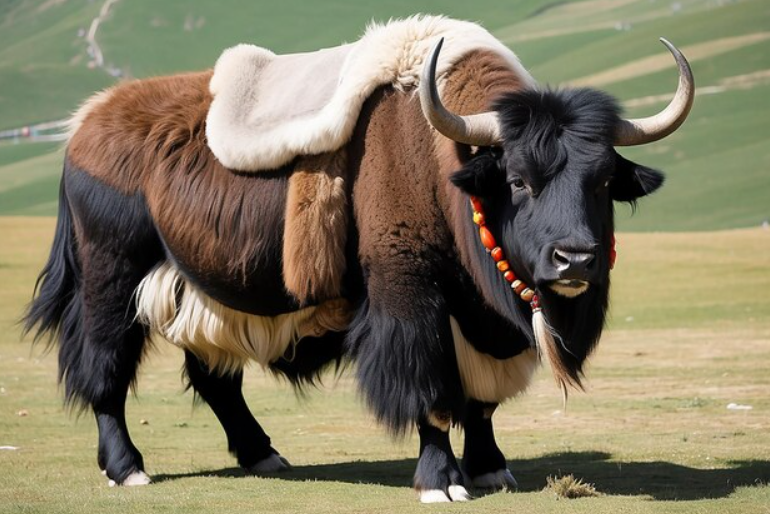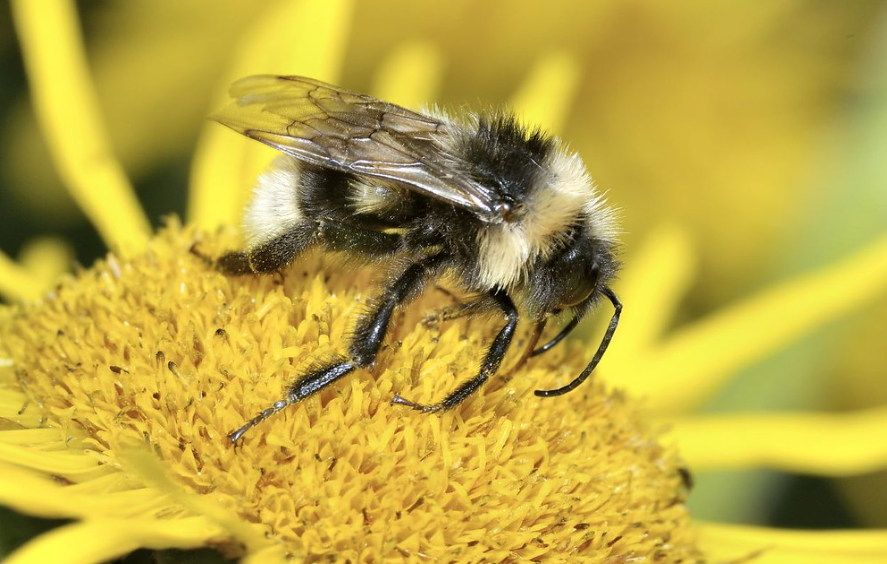
Yak: The Magnificent and Multipurpose Mountain Animal
Bos grunniens, the scientific name for the yak, is a large domesticated animal indigenous to Central Asia, the Tibetan Plateau, and the rocky highlands of the Himalayas. Yaks are renowned for their resilience and have evolved to survive in some of the harshest habitats on Earth. More than just an animal, the yak represents the tenacity and resourcefulness of the mountain peoples of the Himalayas. This is due to its thick fur, strong physique, and significant cultural and economic importance. Below are the physical traits, habitat, domestication, uses, and cultural significance of the yak:
Quick Top 10 Facts about Yak
| SCIENTIFIC NAME | Bos grunniens (Yak) |
| CLASSIFICATION | KINGDOM: Animalia CLASS: Mammalia ORDER: Artiodactyla FAMILY: Bovidae PHYLUM: Chordata GENUS: Bos |
| SIZE | Up to 2 meters (6.6 feet) in height at the shoulder, weighing up to 1,000 kg (2,200 pounds) |
| HABITAT | Native to the Himalayas, found in high-altitude regions of Tibet, Nepal, Bhutan, and parts of northern India |
| DIET | Herbivorous – Feeds on grasses, shrubs, and other high-altitude plants |
| SPECIES | Yak (*Bos grunniens*) |
| COUNTRY | Primarily found in the Himalayan region, including Tibet, Nepal, Bhutan, and northern India |
| GESTATION PERIOD | Approximately 270-280 days |
| LIFE SPAN | Up to 20 years in the wild |
| CONSERVATION STATUS | Not endangered, domesticated yaks are widespread, but wild populations are vulnerable due to habitat loss and overgrazing |
What is a yak?
A yak is a type of bovine and belongs to the Bos genus. Yaks are renowned for their remarkable physical features, which include a thick coat of fur, large horns, and a strong body. These traits help them survive harsh climates at high elevations. There are two main types of yaks: the wild yak (Bos mutus) and the domesticated yak (Bos grunniens). The domesticated variety is more common. While domesticated yaks are an essential part of life for people in mountainous regions like Tibet, Nepal, Bhutan, and parts of China and India, wild yaks can be found in remote areas of the Tibetan Plateau.
Physical Attributes of the Yak
Though related to cattle, yaks are generally smaller, have shorter legs, and are stockier. They are well adapted to the harsh conditions of high altitudes, where temperatures often drop below freezing and oxygen is scarce. Their long, shaggy fur and thick undercoat protect them from the cold. Their hooves are designed to handle rough, uneven terrain, while their noses are adapted to filter out dust and cold air.
Physical Characteristics of the Yak
Adult yaks typically weigh between 300 and 1,200 kilograms (660 and 2,645 pounds), making them large and powerful animals. While their size may vary depending on nutrition and environment, males are usually larger than females. One of the most distinguishing features of yaks is their long, thick fur, which is a major adaptation to the severe alpine environment. This coat consists of a coarse outer layer and a soft, insulating undercoat. The undercoat’s thermal protection allows yaks to endure temperatures as low as -40°C (-40°F).
Yak’s Horns and Eye Structure
Yaks’ horns are another unique feature. Both male and female yaks have horns, though males typically have larger, more curled ones. These horns are used for self-defense, mating rituals, and territorial displays. In high-altitude regions where vision is often poor, yaks’ wide, black eyes help them navigate through dimly lit environments. 
Yak’s Ability to Navigate Rough Terrain
Despite their size, yaks are remarkably agile, particularly in their natural mountainous environments. Their wide, cloven hooves make it easy for them to navigate rough and hilly terrain. Yaks have been domesticated in some of the world’s most isolated areas, partly because they can manage difficult terrain where other animals would struggle.
Yak’s Distribution and Habitat
Yaks are native to the cold, high-altitude regions of the Tibetan Plateau and the Himalayas. These areas, characterised by low temperatures, sparse vegetation, and thin air, are inhospitable to most other species. However, yaks have adapted well to these environments. While some may live at even higher altitudes, they are typically found between 3,000 and 6,000 meters (9,800 and 19,700 feet) above sea level.
Regions Where Yaks Are Found
Most yaks are found in the northern Indian subcontinent, including Tibet, Nepal, Bhutan, and parts of northern India. They can also be found in Qinghai, Sichuan, and the Tibet Autonomous Region of China, with smaller populations in Mongolia and some areas of Kazakhstan. Wild yaks are typically found in remote, deserted areas of the Tibetan Plateau, where they roam the expansive grasslands and graze on limited vegetation.
Domesticated Yaks in the Himalayan Regions
Domesticated yaks, on the other hand, are raised by local people and are well adapted to life in the mountains. Local herders use these animals for transporting goods, providing meat and milk, and producing wool for textiles. They are typically kept at elevations between 2,500 meters (8,200 feet) and 4,000 meters (13,100 feet), where the climate is harsh but manageable for both the animals and their human caretakers.
The Domestication of Yaks
Yaks have been a vital part of high-altitude life for over 5,000 years. Pastoral communities traditionally keep domesticated yaks in herds, using them for food, clothing, and transport. By enabling humans to move cargo, herd animals, and perform daily activities in some of the most extreme conditions, yak domestication transformed life in the Himalayan regions.
Physical Adaptations of Domesticated Yaks
Domesticated yaks are less likely to be overbred than other animals, preserving their resilience and genetic diversity. While domesticated yaks are generally smaller than their wild relatives, they still retain many traits that make them well-suited to survive at high altitudes.
Different Varieties of Domesticated Yaks
Over time, domesticated yaks have evolved to meet the needs of their human caretakers. Various breeds have been developed for different purposes, including as pack animals, for milk production, and for wool harvesting. Some yaks are valued for their meat or milk, while others are kept specifically for their strength and endurance.
Applications of Yaks
Yaks are highly versatile animals that provide a range of resources to their dependents. Their milk is rich in nutrients and can be made into cheese, yoghurt, and butter. Because yak milk is much fattier than cow’s milk, it is particularly useful in areas with high energy needs and limited food sources.
Uses of Yak Meat
In addition to their milk, yaks supply lean, flavorful meat that is commonly used in soups, stews, and other traditional dishes. Yak meat is prized for its rich taste and tender texture, making it a delicacy in various parts of the world. Another important resource is yak wool, which is used to create fabrics and warm clothing. This wool is soft, lightweight, and highly insulating, making it perfect for garments designed for tough alpine conditions.
Yaks as Pack Animals
In many mountainous areas, yaks also serve as important pack animals. Their strength, stamina, and ability to navigate steep, rocky terrain make them ideal for transporting goods. In places where roads are either non-existent or inaccessible, yaks play a crucial role in transporting everything from food and water to building materials and firewood. 
Yaks in Tibetan Culture
While yaks are primarily used for practical purposes, they also hold cultural significance for many Himalayan societies. In Tibetan culture, yaks play an important role in religious rituals and festivals. They are often depicted in Tibetan art as symbols of endurance and perseverance in the face of hardship.
Preservation of Wild Yaks
Despite the widespread presence of domesticated yaks in the Himalayan region, wild yaks are considered “vulnerable” by the International Union for Conservation of Nature (IUCN). The population of wild yaks is at risk due to poaching, competition from domesticated cattle, and habitat destruction. Although domesticated yaks sometimes graze in the same areas as wild yaks, this can lead to resource depletion and environmental damage. Furthermore, wild yaks are often hunted for their meat and fur.
Conservation Efforts for Wild Yaks
To protect wild yaks and their habitats, conservation efforts are underway. These include creating protected areas, enforcing anti-poaching laws, and encouraging sustainable grazing practices for domesticated yaks. The goal is to preserve the delicate balance of high-altitude ecosystems, ensuring that both wild and domesticated yaks continue to thrive in their native habitats.
FAQ (frequently asked questions) about Yak
Q: What is a Yak?
Ans: A Yak is a large domesticated mammal native to the Himalayan region of South Asia, known for its thick fur, horns, and use as a pack animal in high-altitude areas.
Q: Where do Yaks live?
Ans: Yaks primarily live in the high-altitude regions of the Himalayas, Tibetan Plateau, and surrounding areas of Central Asia, where they are adapted to cold, mountainous environments.
Q: What do Yaks eat?
Ans: Yaks are herbivores, grazing on grasses, shrubs, and other vegetation found in the high-altitude pastures where they live.
Q: How do Yaks defend themselves?
Ans: Yaks defend themselves with their strong build, using their powerful horns to fend off predators. They also live in herds for protection and social bonding.
Q: How do Yaks reproduce?
Ans: Yaks reproduce sexually, with the female giving birth to a single calf after a gestation period of approximately 9 months. Calves are cared for by their mothers for several months.
Q: Are Yaks domesticated?
Ans: Yes, yaks have been domesticated for thousands of years and are used as pack animals, for milk production, and for their meat and fur.
Q: How long do Yaks live?
Ans: Yaks typically live for 15 to 20 years in the wild, though their lifespan can be longer when properly cared for in captivity.
Q: What are the characteristics of Yaks?
Ans: Yaks are large, sturdy animals with long, shaggy fur that helps them survive in cold environments. They also have thick horns and are known for their ability to carry heavy loads.
Q: Are Yaks used for milk production?
Ans: Yes, yaks are important for milk production, especially in Tibet and surrounding areas, where yak milk is used to make dairy products like butter, cheese, and yogurt.
Q: Are Yaks endangered?
Ans: Domesticated yaks are not endangered, but wild yaks are considered vulnerable due to habitat loss, poaching, and the impact of climate change on their high-altitude habitats.
#Yak, #MountainYak, #YaksOfInstagram, #TibetanYak, #AnimalLovers, #FarmAnimals, #MountainAnimals, #YakLife, #WoollyCreatures, #DomesticYak, #HighAltitudeAnimals, #WildlifePhotography, #HimalayanYak, #AnimalConservation, #YaksInNature
Our sources and references about Yak
1: Wikipedia
2: National Geographic
3: Encyclopaedia Britannica
4: Himalayan Village


